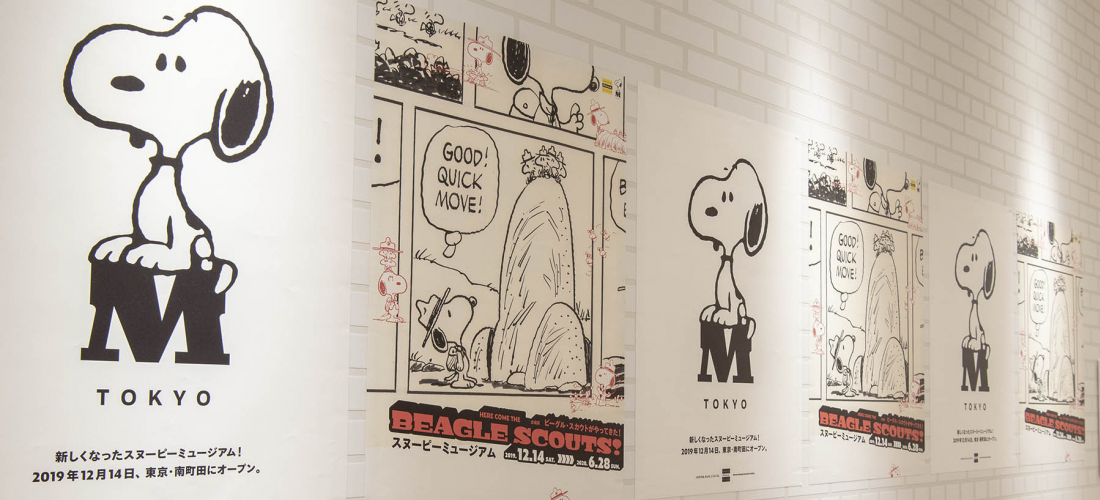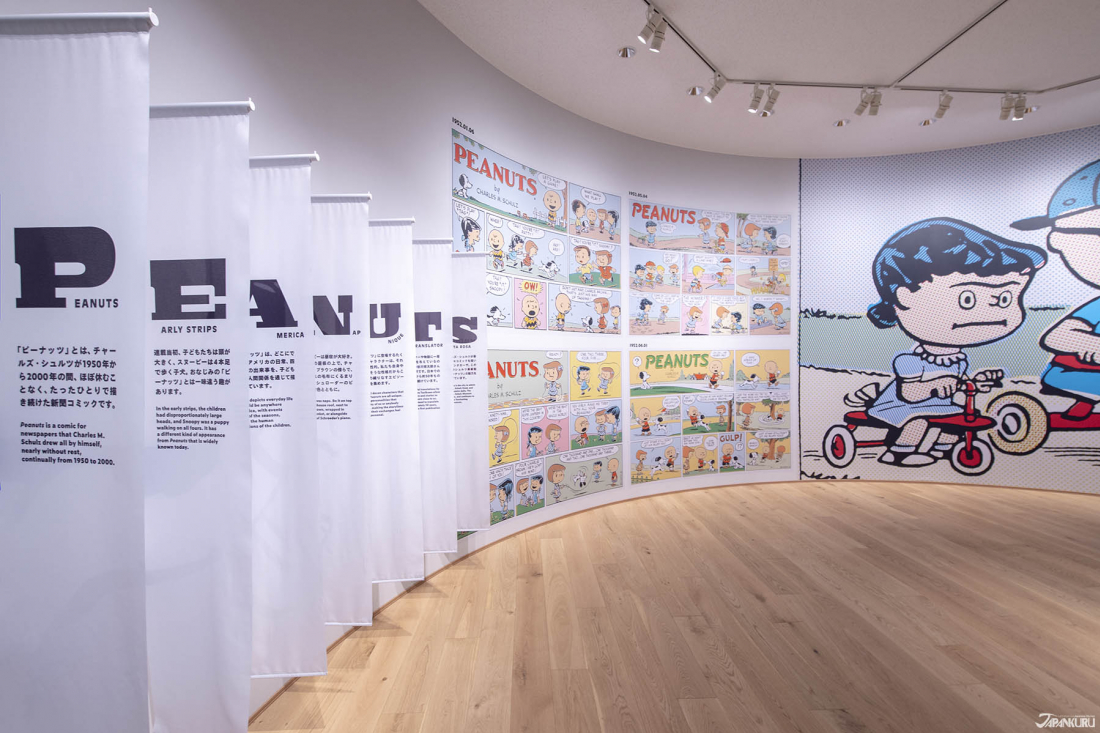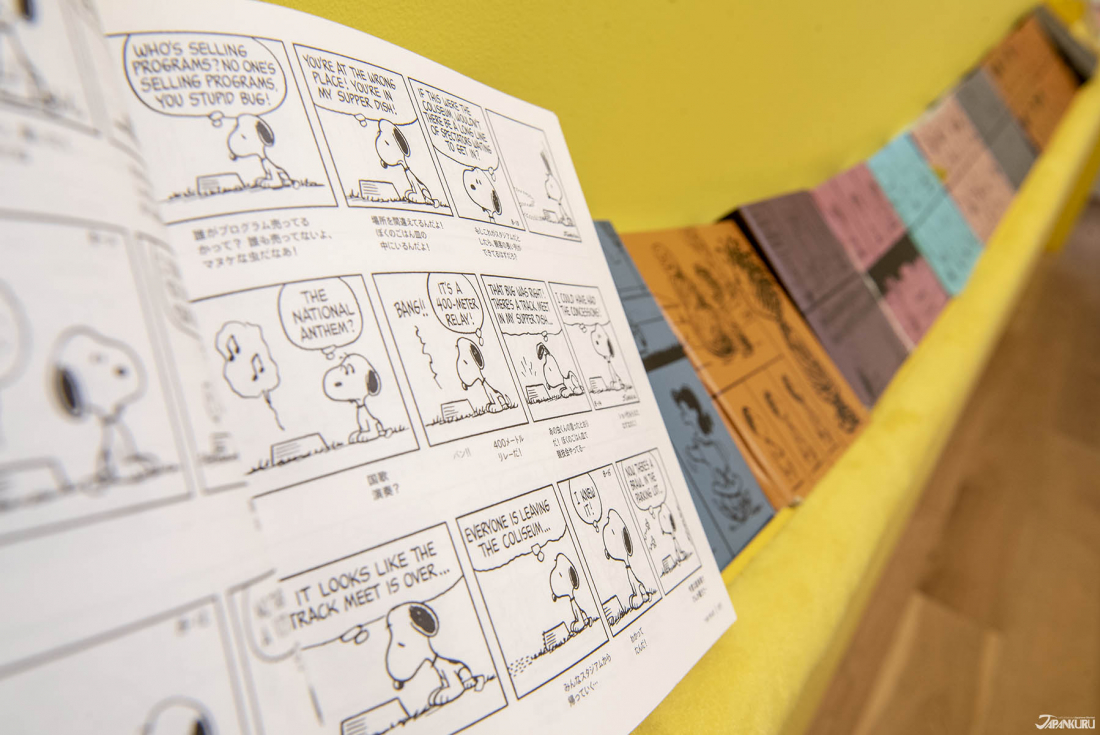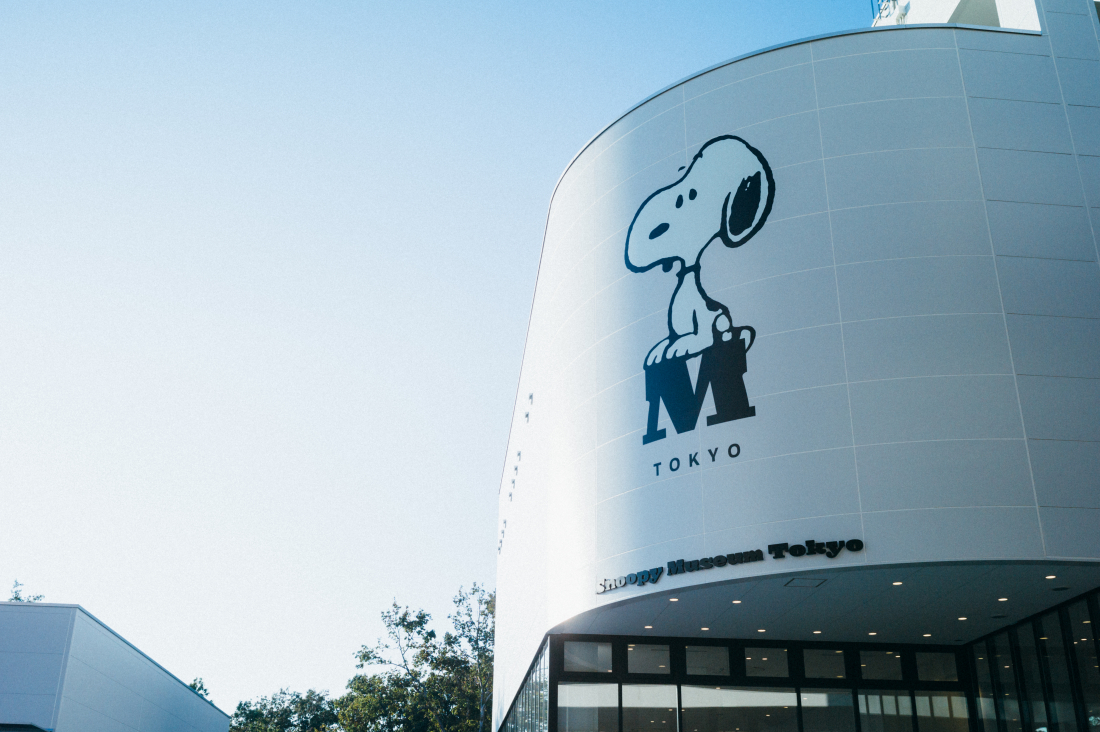CONTENTS
The world’s first Snoopy Museum branch outside of California, and by far the best place in Tokyo for Peanuts fans, we finally got to visit the brand new Snoopy Museum Tokyo in Minami-Machida, and the neighboring PEANUTS Cafe!
Getting to the Brand New Snoopy Museum Tokyo
© Peanuts Worldwide LLC
While the Charles M. Schulz Museum in Santa Rosa, CA has been open for years, Japan's Snoopy Museum Tokyo first came into being in 2016 as a limited-time exhibition in the middle of Tokyo. Two and a half years wasn't enough to satisfy Peanuts fans from all over the world, however! So in December 2019 the museum opened in a new Tokyo facility, expanding to twice its previous size, and thanks in part to an accompanying PEANUTS Cafe, packing twice the Snoopy-filled punch! Nobody on the JAPANKURU team had gotten a chance to visit the previous museum location and see what Snoopy and Charlie Brown were up to there, so we were pretty excited to finally make our way over and see what all the fuss is about.
© Peanuts Worldwide LLC
The museum's brand new building is in the Machida area of Tokyo, a little removed from the hustle and bustle of its previous location. You'll now find it on the edge of the Minami-Machida Grandberry Park outlet mall, bordering the cheerful greenery of Tsuruma Park. If you think doing a little shopping, enjoying some mild Tokyo weather in the park, and immersing yourself in a whole lot of Snoopy sounds like a good time, you might want to make it a whole day trip! We ended up visiting after sunset, so no all-day excursion for us, but the brightly lit museum and cafe were quite welcoming against the dark sky.
To get to the Snoopy Museum Tokyo, you'll want to take the Den-en-toshi Line to Minami-machida Grandberrypark Station, which is just a couple minutes walk from the museum and cafe. If you're in Shibuya (or anywhere on the Tokyo Metro Hanzomon Line) you're in luck, since you can take the train directly over, no transfers! It's unlikely to be a difficult trip from anywhere in the city, though. And once you arrive, there are some pretty cute Snoopys placed strategically around the complex, guiding you to your destination.
Tsuruma 3-1-1, Machida-shi, Tokyo
Access: Minami-machida Grandberrypark Station (or a shuttle bus from both Haneda and Narita airports!)
Hours until February 2020: 10:00 – 20:00 (admission until 19:30)
Hours from March 2020 onwards:
Monday to Thursday 10:00 – 18:00 (admission until 17:30)
Friday to Sunday & Holidays 10:00 – 20:00 (admission until 19:30)
On-Site Tickets*: Adults 2,000 yen / Middle & High School Students 1,000 yen / Children 4 & over 600 yen
Official Website (en)
*(We highly recommend you buy advance tickets instead though – available here. Admission is divided into 5 time slots a day, so advance tickets can help you plan your timing better, and they're also 200 yen cheaper!)
Our Museum Tour Begins
© Peanuts Worldwide LLC
A trip to the museum starts with a bang, as you slip into a dimly lit square room, and slowly but surely, the walls come to life with color and movement! Taking advantage of some playful projection mapping, Snoopy and co explore the walls, climbing stairs and slipping down slides, welcoming you to the museum with an original animation! Our eyes whipping from one wall to the next, it was definitely a fun way to start.
The Charles Shulz Gallery
© Peanuts Worldwide LLC
The museum's permanent exhibition starts, well, just where you might think – at the beginning! Circle the room to learn about the life of the late great Charles Shulz, creator of Snoopy, and the rest of the Peanuts crew. The old photos and explain some of the connections between his personal life and the comic, and we loved seeing some footage of the master at work.
The Peanuts Gang Gallery
© Peanuts Worldwide LLC
This huge room is sure to be a favorite for many fans! Huge displays featuring beloved characters, extra-large reproductions of Peanuts comics throughout the ages, trivia on Snoopy and the Peanuts Gang, and vintage memorabilia of all kinds, it's a Peanuts wonderland in here.
© Peanuts Worldwide LLC
Are you a big fan Sally Brown? Perhaps your favorite comics feature Schroeder plonking away at his little piano? There are areas for a handful of popular characters, each with some of their most iconic comics. And you might notice they all look a little bigger than the strips you read on the Sunday paper's comic page – that's because they're all shown in their original size! We were pretty surprised to learn that Peanuts comics were drawn much larger and then shrunk down for printing, but in retrospect, of course it makes a lot of sense.
If you're wondering, we must admit, at JAPANKURU we love Lucy!
© Peanuts Worldwide LLC
This is the Charlie Brown we all know and love, but the character's changed a little over the years! You"ll have to visit the museum to see vintage Chuck.
© Peanuts Worldwide LLC
(Don't miss the chance to duck outside and take some pictures on the Snoopy Terrace! Hopefully you'll be better at fake playing golf than we were.)
The Snoopy Room
© Peanuts Worldwide LLC
First, visitors get to see a little tribute to the world's first Peanuts-themed museum, the Charlez M. Shulz Musuem.
© Peanuts Worldwide LLC
Then… Can you tell from this picture? These Snoopys are GIANT!
And there are a few different kinds, too! An adorable (and adorably huge) sleeping Snoopy, sliding Snoopy, some old-fashioned Snoopys… all different sizes and scales. If we didn't already feel like we'd entered wonderland before walking into this room, we certainly did afterwards.
© Peanuts Worldwide LLC
Don't miss the chance to meet with terrifying Halloween mask Snoopy, face to face!
The Temporary Exhibition: Here Come the Beagle Scouts!
© Peanuts Worldwide LLC
When we visited, we got to see "Here Come the Beagle Scouts!" Unless you're planning to visit before the end of June 2020, though, you'll probably see something totally different! To keep things fresh, the new Snoopy Museum Tokyo has a temporary exhibition space, meant to host a variety of fun, themed Peanuts displays.
© Peanuts Worldwide LLC
The exhibition talked a little about some classic Beagle Scouts comics (the Peanuts take on the Eagle Scouts, of course)… but we thought the most exciting part of the exhibition was just getting to see real original illustrations!
The galleries in the permanent exhibition spaces have some full-sized comic strips, but because the permanent exhibition is just that (permanent), they can't display anything that might degrade over time in the museum's bright lights. So, the permanent exhibition's comic strips are high-quality prints, not decades-old originals.
© Peanuts Worldwide LLC
Because the temporary exhibitions only put the featured comics on the museum floor for a matter of months, however, they can include the hand-illustrated originals! Look close, and you'll see the real-life handiwork of Charles Shulz. Very cool!
The Woodstock Room
© Peanuts Worldwide LLC
While very young visitors, and their parents, will probably be relieved at the sight of the Woodstock Room's comfy benches and colorful comic books, we suspect museum-goers of all ages will enjoy the ambience.
© Peanuts Worldwide LLC
The columns are fuzzy!!
© Peanuts Worldwide LLC
And there are comics in both English, and Japanese! The room is a nice, relaxing end to the museum tour.
Don’t Leave the Museum So Soon!
The Workshop Room
© Peanuts Worldwide LLC, photo courtesy of the Snoopy Museum Tokyo
If you love to get hands-on when it comes to your favorite things, or just want to have a little bit of extra fun during your visit to the museum, sign up for an activity in the workshop! Make some reservations in advance, and you can participate in one of a number of frequently changing crafty activities that will get your creative juices flowing. Sew yourself a little Peanuts coin purse, or a stuffed toy! Put together a Snoopy-themed candle! Or maybe, for a bit of uniquely Japanese fun, cook up some traditional Japanese sweets… Snoopy-style, of course!
Brown’s Store
© Peanuts Worldwide LLC
Even if, like us, you don't get a chance to try out a workshop activity and make something to take home, you didn't think you were going to leave empty-handed, did you? The giftshop at the Snoopy Museum Tokyo, "Brown's Store," is not only huge… the majority of the products inside are Brown's Store originals!
Is it just us? All the limited-edition merchandise was way too hard to resist!
© Peanuts Worldwide LLC
July Nine Sushi Sacks with featuring Beagle Scout Snoopy, classic Japanese Morinaga sweets (including their delectable milk caramels) with vintage Charlie Brown on the box, special Tokyo memento mint tins, and Peanuts paper tape in widths and designs galore… you might happily blow your budget going a little crazy here! You can buy a fair number of the original products on the Brown's Store webshop page if you really want (and get them shipped to you during your stay in Japan), but we decided to use it more as a shopping list creator!
© Peanuts Worldwide LLC
Not only were there tons of products made in collaboration with popular brands…
© Peanuts Worldwide LLC
…But those products often revealed some hidden Peanuts-themed surprises!
© Peanuts Worldwide LLC
Found yourself frustrated as you try to decide between the many souvenirs you wish would all fit in your suitcase? Well, if you've got a nickel, maybe Snoopy can help.
Goodbye to the Museum!
© Peanuts Worldwide LLC
While we were sad that our tour was coming to an end, the Snoopy chandeliers did make for an excellent finale.
Heading Next Door, to the PEANUTS Cafe
© Peanuts Worldwide LLC
Just because we'd finished exploring the Snoopy Museum Tokyo didn't mean our Peanuts-themed night was over! It was time for dinner at the PEANUTS Cafe, which is kind of a fascinating mix of playful theming and surprising sophistication. Walk in to the seating area, and your eyes will immediately be drawn to the bright red doghouse shaped structure in the center of the room. Let your eyes wander, and you might start to ponder… is this a cutesy destination for little kids, or an elegant cafe? The answer is really a little of both! We really appreciated the touches of Snoopy detailing in among the relaxed, simple interior.
© Peanuts Worldwide LLC
Instead of kitschy character theming, we found that the cafe was actually sort of picnic themed! We were told that the concept for the menu was "if the Peanuts gang had a potluck-style picnic, what would they all bring?" In fact, if the weather's nice, you can grab something from their take-out menu and actually picnic for real in Tsuruma Park, right next door. Since it was a little dark when we arrived, and a little cold outside, we opted for a table inside the dog house, and sat in chairs printed with characters' likenesses.
Since the chefs at the PEANUTS Cafe aren't distracted focusing on recreating the perfect Snoopy face in a pile of rice, the food was actually delicious. Impressively juicy grilled chicken, savory meatballs, buttery American-style biscuits (served with maple syrup to boot), everything was good enough that we think it's a pretty good choice for a meal whether you love Peanuts or not. Then again, who doesn't appreciate a good classic Sunday comic strip?
It's hard to imagine the kids from the comics being such good chefs, though. I doubt their potluck picnic would be so tasty!
© Peanuts Worldwide LLC
If you just want a snack after walking around the museum, their pancakes are a solid choice! And the S'Mores Shake was predictably delicious. With a bit of a Beagle Scouts theme throughout the cafe, there had to be something s'more flavored! Perhaps the most unique flavor profile out of everything was the smoothie we tried, which tasted of tart red fruits, and finished with the distinctly metallic tang of beets!
© Peanuts Worldwide LLC
Continuing with the theme of original merchandise, we were charmed enough by the plates, napkins, and silverwear at the cafe that we wished aloud that we could take it home with us as well… and were promptly told that we could indeed buy all of those things at the gift shop. Very tempting.
© Peanuts Worldwide LLC
Although the most popular souvenir choice from the PEANUTS Cafe is apparently these limited-edition tins of konpeito, the colorful Japanese candies you might recognize from some Japanese animation. They actually come in the unique balloon-like plastic bags you see all the way on the left, here.
Tsuruma 3-1-1, Machida-shi, Tokyo
Hours: 10:00 to 22:00 (last order 21:00)
Official Website (jp)
Next Time, We’ll Come for a Picnic!
© Peanuts Worldwide LLC
And before we knew it, we were done with dinner, and on our way home. (Of course, not before searching out this series of giant statues, showing the evolution of Snoopy over the years!) It had been a pretty exciting evening out in Machida, and we'd all seen more Snoopy in these few hours than we'd probably seen over the past few years. But there's no question – when the temporary exhibit changes next June, we'll be ready to do it all over again!
Have you been to the brand new Snoopy Museum Tokyo already? Did you visit the museum in its original location? Perhaps you have a tour of PEANUTS Cafes and Snoopy-themed spots in the planning stages right now? Let us know about your time in Tokyo, or your upcoming plans, on twitter, instagram, and facebook!
© Peanuts Worldwide LLC, photo courtesy of the Snoopy Museum Tokyo.
Next time, maybe we'll make it during daylight hours!
Details
NAME:Snoopy Museum Tokyo & Peanuts Cafe
MAP
ACCESS:Minami-machida Grandberrypark Station
COMMENT
FEATURED MEDIA
VIEW MOREMAP OF JAPAN
SEARCH BY REGION

LATEST
VIEW MOREEVENT CALENDAR
VIEW MOREMOST POPULAR
 Tokyo Winter Recommendation: Don’t Miss Tokyo Mega Illumination, Japan’s #1 Light Show
Tokyo Winter Recommendation: Don’t Miss Tokyo Mega Illumination, Japan’s #1 Light Show ป้ายยาสินค้าน่าซื้อในร้านขายยาญี่ปุ่น | KOWA ผลิตภัณฑ์เพื่อสุขภาพสำหรับคนยุคใหม่
ป้ายยาสินค้าน่าซื้อในร้านขายยาญี่ปุ่น | KOWA ผลิตภัณฑ์เพื่อสุขภาพสำหรับคนยุคใหม่ Okinawa Family Road Trip: Japanese Glasses Shopping at San-A Urasoe West Coast PARCO CITY, Discount Coupons, & Okinawa Sightseeing with JINS
Okinawa Family Road Trip: Japanese Glasses Shopping at San-A Urasoe West Coast PARCO CITY, Discount Coupons, & Okinawa Sightseeing with JINS





































 >> Find out more at Japankuru.com! (link in bio)
#
>> Find out more at Japankuru.com! (link in bio)
#





 The Robot Restaurant is gone, but the Samurai Restaurant is here to take its place. Check it out, and don't forget your coupon!
The Robot Restaurant is gone, but the Samurai Restaurant is here to take its place. Check it out, and don't forget your coupon!
 신주쿠의 명소 로봇 레스토랑이 사무라이 레스토랑으로 부활! 절찬 쿠폰 발급중
신주쿠의 명소 로봇 레스토랑이 사무라이 레스토랑으로 부활! 절찬 쿠폰 발급중
 18歲以上才能入場的歌舞秀,和你想的不一樣!拿好優惠券去看看~
#tokyo #shinjuku #samurairestaurant #robotrestaurant #tokyotrip #도쿄여행 #신주쿠 #사무라이레스토랑 #이색체험 #할인이벤트 #歌舞伎町 #東京景點 #武士餐廳 #日本表演 #日本文化體驗 #japankuru #japantrip #japantravel #japanlovers #japan_of_insta
18歲以上才能入場的歌舞秀,和你想的不一樣!拿好優惠券去看看~
#tokyo #shinjuku #samurairestaurant #robotrestaurant #tokyotrip #도쿄여행 #신주쿠 #사무라이레스토랑 #이색체험 #할인이벤트 #歌舞伎町 #東京景點 #武士餐廳 #日本表演 #日本文化體驗 #japankuru #japantrip #japantravel #japanlovers #japan_of_insta
 코지마 x 빅 카메라 쿠폰으로 일본 가전 제품 쇼핑하기
#pr #japankuru #japanshopping #kojima #biccamera #japaneseskincare #yaman #dji #osmopocket3 #skincaredevice #日本購物 #美容儀 #相機 #雅萌 #日本家電 #일본여행 #면세 #여행꿀팁 #일본쇼핑리스트 #쿠폰 #일본쇼핑 #일본브랜드 #할인 #코지마 #빅카메라 #japankurucoupon
코지마 x 빅 카메라 쿠폰으로 일본 가전 제품 쇼핑하기
#pr #japankuru #japanshopping #kojima #biccamera #japaneseskincare #yaman #dji #osmopocket3 #skincaredevice #日本購物 #美容儀 #相機 #雅萌 #日本家電 #일본여행 #면세 #여행꿀팁 #일본쇼핑리스트 #쿠폰 #일본쇼핑 #일본브랜드 #할인 #코지마 #빅카메라 #japankurucoupon






























 Oita Hello Kitty Airport
Oita Hello Kitty Airport  Lands April 13th
Lands April 13th























